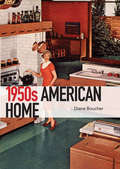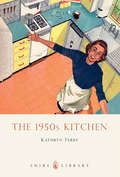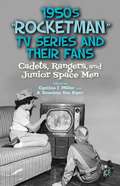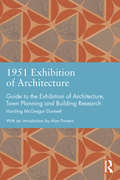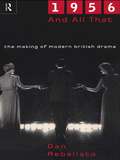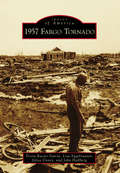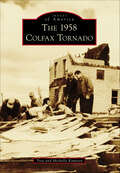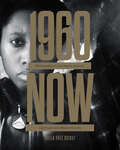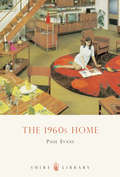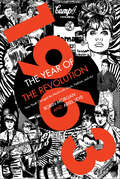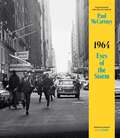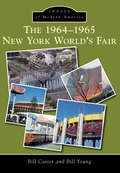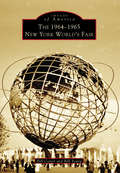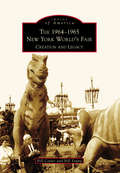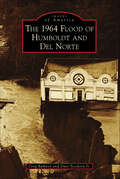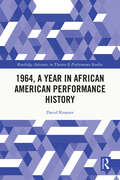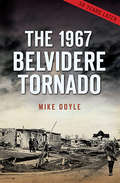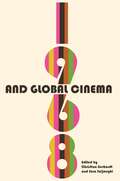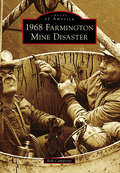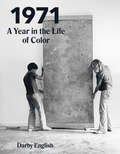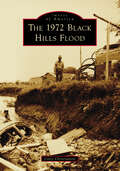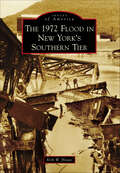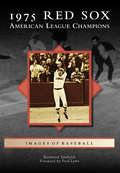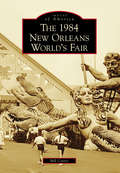- Table View
- List View
The 1950s American Home
by Diane BoucherThis title explores what life was like in the 1950s American home. An age of optimism, it is about living the American Dream and how this was achieved, changes in the home, new convenience technology, new ways of living. From Ranch House to American Modernism to affordable homes in the suburbs, this was how to live the good life in an era of unprecedented prosperity and opportunity.From the Trade Paperback edition.
The 1950s Kitchen
by Kathryn FerryThe 1950s was the first great age of the modern kitchen: labor-saving appliances, bright colors and the novelty of fitted units moved the kitchen from dankness into light, where it became the domain of the happy housewife and the heart of the home. Formica - a new space-age material - decorated with fashionable patterns topped sleek cupboards that contained new classic wares such as Pyrex and 'Homemaker' crockery, and the ingredients for 1950s British staples: semolina, coronation chicken and spotted dick. Electricity entered the kitchens of millions, and nowhere in the home was modern technology and modern design more evident. Bold color, clean lines and stainless steel were keynotes of the decade, and it is no surprise that 1950s kitchen style is now the height of fashion once again, with names like Cath Kidston picking up on the best of '50s kitchen kitsch, and manufacturers like Dualit, Kitchen Aid and Aga doing healthy business with retro appliances. This book - a celebration of cooking, eating and living in the 1950s kitchen - is a feast of nostalgia, and a mine of inspiration for anyone wanting to recreate that '50s look in their own home.From the Trade Paperback edition.
1950s "Rocketman" TV Series and Their Fans
by Cynthia J. MillerThe fourteen essays featured here focus on series such as Space Patrol, Tom Corbett, and Captain Z-Ro, exploring their roles in the day-to-day lives of their fans through topics such as mentoring, promotion of the real-world space program, merchandising, gender issues, and ranger clubs - all the while promoting the fledgling medium of television.
1951 Exhibition of Architecture: Guide to the Exhibition of Architecture, Town Planning and Building Research (Studies in International Planning History)
by Harding McGregor DunnettThe Festival of Britain is perhaps best known for its South Bank Exhibition promoting British science and art to the post-war world, but one of the most important elements was the Architecture Exhibition, based in Poplar in East London. This exhibition was used to demonstrate the principles of modern town planning that had been laid out by Abercrombie, in particular in his County of London Plan. The project was named after George Lansbury, the Labour MP, London County Council (LCC) member and Poplar councillor. It was an effective demonstration of planning ideas adopted since the 1930s by influential planners, taking the village as a model and retaining the terraced house as a housing option among medium rise flats. Small squares and open spaces were favoured, with paved pedestrian spaces, all at lower than pre-war densities. The guide is revealing of the broader thinking in English planning in the mid century. It provides an opportunity for looking at conflicts among advocates of different planning ideas in the period of reconstruction and the move by architects to regain control of LCC housing from the Valuer’s Department. It offers the model of integrated professional specialisms that was seen as central to Modernism’s mission. It is also an opportunity to describe in more detail the interaction of different professions, including, for example, a sociologist, employed by the LCC in the creation of a model for reconstruction.
1956 and All That: The Making of Modern British Drama
by Dan RebellatoIt is said that British Drama was shockingly lifted out of the doldrums by the 'revolutionary' appearance of John Osborne's Look Back in Anger at the Royal Court in May 1956. But had the theatre been as ephemeral and effeminate as the Angry Young Men claimed? Was the era of Terence Rattigan and 'Binkie' Beaumont as repressed and closeted as it seems? In this bold and fascinating challenge to the received wisdom of the last forty years of theatrical history, Dan Rebellato uncovers a different story altogether. It is one where Britain's declining Empire and increasing panic over the 'problem' of homosexuality played a crucial role in the construction of an enduring myth of the theatre. By going back to primary sources and rigorously questioning all assumptions, Rebellato has rewritten the history of the Making of Modern British Drama.
1957 Fargo Tornado (Images of America)
by Trista Raezer-Stursa Lisa Eggebraaten Jylisa Doney John HallbergOn the evening of June 20, 1957, a tornado ripped through Fargo, North Dakota. It caused the deaths of seven children and five adults and left 116 injured. The tornado destroyed 359 buildings and damaged 2,543 more. The nine-mile path of destruction covered over 66 blocks in town, leaving more than 2,000 people homeless and causing approximately $20 million worth of damage. Following the tornado, first responders quickly united to aid those in need, setting up disaster headquarters, finding shelter for over 600 people, and distributing more than 100 tons of clothing and bedding. Dr. Tetsuya Fujita, a meteorologist, studied the Fargo tornado when creating the Fujita scale (F-scale) and later rated it an F5, the most destructive rating. Images of America: 1957 Fargo Tornado, shines a light on the tornado's destruction and the rebuilding of a united and vibrant community.
The 1958 Colfax Tornado (Images of America)
by Troy KnutsonJune 4, 1958, was a muggy and breezy day in western Wisconsin. Across central Minnesota, severe weather was brewing. In the early afternoon, the Minnesota storms crossed the border into Wisconsin. As farmers were tending to milking chores and families were wrapping up the workday and sitting down to supper, one of the worst tornadoes in Wisconsin's history touched down. At 7:07 p.m., what had been multiple, smaller tornadoes combined into one massive F5 tornado that ripped through the village of Colfax, leaving a path of death and destruction that would require months of recovery. In Colfax, 12 people were killed, hundreds were injured, and millions of dollars in damage was done to property. However, in the wake of the storm, a community and its neighbors came together as one to care for the survivors and begin the process of healing and rebuilding.
1960Now: Photographs of Civil Rights Activists and Black Lives Matter Protests
by Sheila Pree BrightA “powerful photo collection” documenting the Black Lives Matter movement and its parallels to the historic fight for civil rights (Publishers Weekly).The fight for equality continues, from 1960 to now. Combining portraits of past and present social justice activists with documentary images from recent protests throughout the United States, #1960Now sheds light on the parallels between the 1960s Civil Rights Movement and the Black Lives Matter movement of today. Shelia Pree Bright’s striking black-and-white photographs capture the courage and conviction of ‘60s leaders and a new generation of activists, offering a powerful reminder that the fight for justice is far from over. #1960Now represents an important new contribution to American protest photography.“Visually arresting . . . activism photography shot across the U.S., from Ferguson, Missouri, to Atlanta to Philadelphia.” —Essence“While millions of cellphone photos are generated each day—some forceful testaments to racial violence and injustice—few possess the grace and quiet lyricism of her images.” —The New York Times Lens blog
The 1960s Home
by Paul EvansThe 1960s witnessed a sustained period of economic growth, consumer spending and stable employment. This hitherto unknown prosperity enabled a market growth in levels of owner occupation and a subsequent boom in the sale of household furnishings and luxury goods. The 1960s Home looks at the styles and fashions in domestic housing and interiors between 1960 and 1970. Although this period has received increasing attention in recent years, much of it has been concentrated on progressive and exclusive design rather than on the furniture and furnishing of the 'average' home.From the Trade Paperback edition.
1963: How Youth Changed the World with Music, Fashion, and Art
by Robin Morgan Ariel LeveBeginning in London and ricocheting across the Atlantic, 1963: The Year of the Revolution is an oral history of twelve months that changed our world—the Youth Quake movement—and laid the foundations for the generation of today.Ariel Leve and Robin Morgan's oral history is the first book to recount the kinetic story of the twelve months that witnessed a demographic power shift—the rise of the Youth Quake movement, a cultural transformation through music, fashion, politics, theater, and film. Leve and Morgan detail how, for the first time in history, youth became a commercial and cultural force with the power to command the attention of government and religion and shape society.While the Cold War began to thaw, the race into space heated up, feminism and civil rights percolated in politics, and JFK’s assassination shocked the world, the Beatles and Bob Dylan would emerge as poster boys and the prophet of a revolution that changed the world.1963: The Year of the Revolution records, documentary-style, the incredible roller-coaster ride of those twelve months, told through the recollections of some of the period’s most influential figures—from Keith Richards to Mary Quant, Vidal Sassoon to Graham Nash, Alan Parker to Peter Frampton, Eric Clapton to Gay Talese, Stevie Nicks to Norma Kamali, and many more.
1964: Eyes of the Storm
by Paul McCartney“Millions of eyes were suddenly upon us, creating a picture I will never forget.” —Paul McCartney Taken with a 35mm camera by Paul McCartney, these largely unseen photographs capture the explosive period, from the end of 1963 through early 1964, in which The Beatles became an international sensation and changed the course of music history. Featuring 275 images from the six cities—Liverpool, London, Paris, New York, Washington, D.C., and Miami—of these legendary months, 1964: Eyes of the Storm also includes: • A personal foreword in which McCartney recalls the pandemonium of British concert halls, followed by the hysteria that greeted the band on its first American visit • Candid recollections preceding each city portfolio that form an autobiographical account of the period McCartney remembers as the “Eyes of the Storm,” plus a coda with subsequent events in 1964 • “Beatleland,” an essay by Harvard historian and New Yorker essayist Jill Lepore, describing how The Beatles became the first truly global mass culture phenomenon Handsomely designed, 1964: Eyes of the Storm creates an intensely dramatic record of The Beatles’ first transatlantic trip, documenting the radical shift in youth culture that crystallized in 1964. “You could hold your camera up to the world, in 1964. But what madness would you capture, what beauty, what joy, what fury?” —Jill Lepore
1964-1965 New York World's Fair, The: Creation And Legacy (Images of Modern America)
by Bill Cotter Bill YoungAdvertised as the "Billion-Dollar Fair," the 1964-1965 New York World's Fair transformed a sleepy park in the borough of Queens into a fantasy world enjoyed by more than 51 million visitors from around the world. While many countries and states exhibited at the fair, the most memorable pavilions were built by the giants of American industry. Their exhibits took guests backward and forward in time, all the while extolling how marvelous everyday life would be through the use of their products. Many of the techniques used in these shows set the standard for future fairs and theme parks, and the pavilions that housed them remain the most elaborate structures ever built for an American fair. The 1964-1965 New York World's Fair showcases the beauty of this international spectacular through rare color photographs, published here for the first time.
1964-1965 New York World's Fair, The: Creation And Legacy (Images of America)
by Bill Cotter Bill YoungThe 1964-1965 New York World's Fair was the largest international exhibition ever built in the United States. More than one hundred fifty pavilions and exhibits spread over six hundred forty-six acres helped the fair live up to its reputation as "the Billion-Dollar Fair." With the cold war in full swing, the fair offered visitors a refreshingly positive view of the future, mirroring the official theme: Peace through Understanding. Guests could travel back in time through a display of full-sized dinosaurs, or look into a future where underwater hotels and flying cars were commonplace. They could enjoy Walt Disney's popular shows, or study actual spacecraft flown in orbit. More than fifty-one million guests visited the fair before it closed forever in 1965. The 1964-1965 New York World's Fair captures the history of this event through vintage photographs, published here for the first time.
1964-1965 New York World's Fair, The: Creation and Legacy (Images of America)
by Bill Cotter Bill YoungWhen the gates of the 1964-1965 New York World's Fair swung open on April 24, 1964, the first of more than 51 million lucky visitors entered, ready to witness the cutting edge of worldwide technology and progress. Faced with a disappointing lack of foreign participants due to political contention, the fair instead showcased the best of American industry and science. While multimillion-dollar pavilions predicted colonies on the moon and hotels under the ocean, other forecasts, such as the promises of computer technology, have surpassed even the most optimistic predictions of the fair. The 1964-1965 New York World's Fair: Creation and Legacy uses rare, previously unpublished photographs to examine the creation of the fair and the legacies left behind for future generations.
The 1964 Flood of Humboldt and Del Norte
by Greg Rumney Dave Stockton Jr.The 1964 flood in the Eel and Klamath Rivers drainages represents an extreme weather event. Both the Northern California and Southern Oregon coasts are host to many floods, but the 1964 flood stands out as a representation of the "perfect storm." Three events occurred that led to the flood. First, a cold front moved in and dropped several feet of snow. Second, a warm front called the "pineapple connection" moved in and released lots of rain while melting the snowfall--local measurements varied from 20 to 32 inches of rainwater in three days. And third, the highest tide of the year had backed up debris and water for several miles. At its peak, the Eel River was discharging more than 800,000 cubic feet per second. Another contributing factor was that besides being one of the fastest rising and falling rivers in the world, the Eel River has the heaviest sediment load second only to the Yellow River in China.
1964, A Year in African American Performance History (ISSN)
by David KrasnerThis book examines the Civil Rights Movement from the perspective of a single year, 1964.The book analyses specific events that occurred in 1964 as benchmarks of the Civil Right Movement, making the case that 1964 was a watershed year. Each chapter considers individually politics, rhetoric, sports, dramatic literature, film, art, and music, breaking down the events and illustrating their importance to the social and political life in the United States in 1964. This study emphasizes 1964 as a nodal point in the history of the Civil Rights Movement, arguing that it was within this single year that the tide against racism and injustice turned markedly.This book will be of great interest to the scholars and students of civil rights, theatre and performance, art history, and drama literature.
1967 Belvidere Tornado, The: A 40-year Anniversary Perspective (Disaster)
by Mike DoyleClaiming the lives of seven adults and seventeen children, the Belvidere tornado struck the most vulnerable at the worst possible time: just as school let out. More than five hundred people suffered injuries. New interviews and fascinating archival history underscore the horrific drama, as well as the split-second decisions of victims and survivors that saved their families and neighbors. Since the tragedy, three more devastating tornadoes have further defined Boone County’s resilience: Poplar Grove in 2008, Caledonia in 2010 and Fairdale in 2015.
1968 and Global Cinema (Contemporary Approaches to Film and Media Series)
by Paula Rabinowitz Pablo La Parra-Perez Laurence Coderre Victor Fan J. M. Tyree Sarah Hamblin Allyson Nadia Field Man-tat Terence Leung Mauro Resmini Graeme Stout David Desser Morgan Adamson Rita De Grandis Peter Hames Rocco Giansante Lily Saint Robert Stam Sara Saljoughi Christina Gerhardt1968 and Global Cinema addresses a notable gap in film studies. Although scholarship exists on the late 1950s and 1960s New Wave films, research that puts cinemas on 1968 into dialogue with one another across national boundaries is surprisingly lacking. Only in recent years have histories of 1968 begun to consider the interplay among social movements globally. The essays in this volume, edited by Christina Gerhardt and Sara Saljoughi, cover a breadth of cinematic movements that were part of the era's radical politics and independence movements. Focusing on history, aesthetics, and politics, each contribution illuminates conventional understandings of the relationship of cinema to the events of 1968, or "the long Sixties." The volume is organized chronologically, highlighting the shifts and developments in ideology in different geographic contexts. The first section, "The Long Sixties: Cinematic New Waves," examines both the visuals of new cinemas, as well as new readings of the period's politics in various geopolitical iterations. This half of the book begins with an argument that while the impact of Italian Neorealism and the French New Wave on subsequent global new waves is undeniable, the influence of cinemas of the so-called Global South is pivotal for the era's cinema as well. The second section, "Aftershocks," considers the lasting impact of 1968 and related cinematic new waves into the 1970s. The essays in this section range from China's Cultural Revolution in cinema to militancy and industrial struggle in 1970s worker's films in Spain. In these ways, the volume provides fresh takes and allows for new discoveries of the cinemas of the long 1968. 1968 and Global Cinema aims to achieve balance between new readings of well-known films, filmmakers, and movements, as well as new research that engages lesser-known bodies of films and film texts. The volume is ideal for graduate and undergraduate courses on the long sixties, political cinema, 1968, and new waves in art history, cultural studies, and film and media studies.
1968 Farmington Mine Disaster (Images of America)
by Bob CampioneCoal in the United States was discovered in the 18th century by landowners and farmers on the slopes of the hillsides in the Appalachian region. It was not until the late 19th century that this black rock would become a part of an industrial revolution. One of the first mines to commercially produce coal was in Fairmont, West Virginia, and began the Consolidated Coal Corporation. On November 20, 1968, the Farmington No. 9 mine explosion changed the course of safety for future mining and the lives of 78 families whose sons, husbands, fathers, and loved ones never came back from the cateye shift the next day.
1971: A Year in the Life of Color
by Darby EnglishIn this book, art historian Darby English explores the year 1971, when two exhibitions opened that brought modernist painting and sculpture into the burning heart of United States cultural politics: Contemporary Black Artists in America, at the Whitney Museum of American Art, and The DeLuxe Show, a racially integrated abstract art exhibition presented in a renovated movie theater in a Houston ghetto.1971: A Year in the Life of Color looks at many black artists’ desire to gain freedom from overt racial representation, as well as their efforts—and those of their advocates—to further that aim through public exhibition. Amid calls to define a “black aesthetic,” these experiments with modernist art prioritized cultural interaction and instability. Contemporary Black Artists in America highlighted abstraction as a stance against normative approaches, while The DeLuxe Show positioned abstraction in a center of urban blight. The importance of these experiments, English argues, came partly from color’s special status as a cultural symbol and partly from investigations of color already under way in late modern art and criticism. With their supporters, black modernists—among them Peter Bradley, Frederick Eversley, Alvin Loving, Raymond Saunders, and Alma Thomas—rose above the demand to represent or be represented, compromising nothing in their appeals for interracial collaboration and, above all, responding with optimism rather than cynicism to the surrounding culture’s preoccupation with color.
1972 Black Hills Flood, The (Images of America)
by Corey ChristiansonOver 50 years have passed since the Black Hills flood swept through western South Dakota in 1972, leaving tragedy in its wake. This book explores the extent of the damage through images that highlight Rapid City, Keystone, and the surrounding Black Hills. Dignitaries, including Sen. George McGovern, visited the Black Hills in the aftermath; these visitors, along with the actions taken for recovery, make an appearance in the story. Today, the Black Hills are a tourist destination, with Mount Rushmore National Memorial, Crazy Horse Memorial, and Custer State Park being the most well-known attractions. /Corey Christianson has spent years researching the 1972 Black Hills flood. She was a part of the 50th commemoration of the flood, for which she, along with a team of talented individuals, created an award-winning exhibit about the flood and the recovery of the Black Hills. The images in this book are from the Rapid City Public Library, US Air Force, Keystone Area Historical Society, and other organizations that strive to remember, honor, and commemorate the flood. /
The 1972 Flood in New York's Southern Tier (Images of America)
by Kirk W. HouseIn June 1972, Hurricane Agnes hit the East Coast with a monstrous and devastating force, bringing a deluge across multiple states and slamming four counties in the Southern Tier: Steuben, Chemung, Tioga, and Broome.Dozens died and property damage ran into the millions as Corning, Elmira, Owego, Binghamton, and other communities suddenly found themselves under water. The flood destroyed the Erie Lackawanna Railroad, staggered the Penn Central, shut down Corning Glass Works for weeks, and devastated the Corning Museum of Glass--a major cultural resource. Lives and landscapes were forever changed when homes and businesses washed away in a matter of minutes. Henceforth, the region's history became permanently divided into the times before and the times after the 1972 flood. Through stunning images, The 1972 Flood in New York's Southern Tier chronicles the extraordinary destruction of twisted rail lines, devastated streets, exhausted recovery workers, rivers bursting their banks, cars on houses, and houses on cars
The 1975 Portland Timbers: The Birth of Soccer City, USA (Sports)
by Michael OrrRelive the magic of the Portland Timbers' 1975 season and the birth of Soccer City, USA. This is the story of seventeen players and two coaches who came from different clubs and different countries to form a team just days before their inaugural game. In this fast-paced account, Michael Orr weaves together player interviews, news coverage, and game statistics to capture the Timbers' single-season journey from expansion team to championship contender. From the first televised game against Pele's New York Cosmos to the seven-game winning streak that vied for a league record and the post-season battle for the game's highest prize, rediscover how, in just four months, the Timbers won the hearts of Portlanders and left an indelible stamp on the Rose City's sporting landscape.
1975 Red Sox: American League Champions (Images of Baseball)
by Raymond Sinibaldi Fred LynnThe 1975 American League Champion Boston Red Sox squared off with the Cincinnati Reds in what is widely recognized as one of the best World Series ever played. The Major League Baseball Network has named its sixth game "the greatest game ever played." The Red Sox were led by two rookies, 21-year-old Jim Rice and 22-year-old Fred Lynn, who formed a rookie duo the likes of which baseball had never seen. They combined with a budding superstar in Carlton Fisk and his aging counterpart Carl Yastrzemski to lead the Red Sox attack, while a wily Luis Tiant anchored the pitching staff. After a first-round sweep of the three-time World Champion Oakland A's, they advanced to a Fall Classic that echoes through the ages, and in the words of Carlton Fisk, the Red Sox won "three games to four.
1984 New Orleans World's Fair, The (Images of America)
by Bill CotterIn 1984, the city of New Orleans hosted the last world's fair held in the United States. Conceived as part of an ambitious effort to revitalize a dilapidated section of the city and establish New Orleans as a year-round tourist destination, it took more than 12 years of political intrigue and design changes before the gates finally opened. Stretching 84 acres along the Mississippi River, the fair entertained more than seven million guests with a colorful collection of pavilions, rides, and restaurants during its six-month run. While most world's fairs lose money, the 1984 New Orleans World's Fair had the dubious distinction of going bankrupt and almost closing early. However, the $350-million investment did succeed in bringing new life to the area, which is now home to the city's convention center and a bustling arts district.
